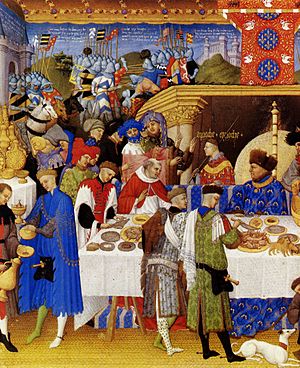Service à la française facts for kids
Service à la française (pronounced "ser-vees ah lah frahn-sez") means "service in the French style." It's a way of serving food where many different dishes are placed on the table all at once. Guests then help themselves to whatever they want. This is different from service à la russe (pronounced "ser-vees ah lah roos"), or "service in the Russian style." In that style, servants bring dishes to the table one by one and serve food to each person.
From the Middle Ages until the 1800s, fancy dinners often used the French style. Today, most restaurants use the Russian style. However, the French style still exists in the form of a buffet. It's also popular for meals at home, parties, and other group events. It's similar to how many Chinese restaurants serve large groups.
There was also a less formal way of serving called service à l'anglaise ("English service"). In this style, the hostess would serve soup from one end of the table. The host would carve meat at the other end. Servants would then take these portions to the guests. Guests would help themselves to other dishes on the table.
Contents
History of French Style Serving
The formal service à la française became popular during the Baroque period. This was helped by new cookbooks that showed how grand meals were served at the French royal court. Famous books like Le Cuisinier françois (1651) helped spread these ideas. France became a leader in food and fashion across Europe. By the 1700s, the French style was used everywhere. Wealthy families even hired French chefs.
During the 1800s, service à la française slowly got replaced by service à la russe for fancy meals. The Russian style had some benefits. Food stayed much hotter when it reached the diner. It also meant fewer dishes were on the table at once. Everyone could try what they wanted, which wasn't always possible with the old system.
However, the Russian style also had downsides. The amazing sight of a table full of food was gone. It also needed more servants and more tableware. This made it very expensive, so only the richest people could afford it. The Russian style also made meals shorter and used less food overall.
How Meals Were Organized
Meals were usually split into two, three, or four parts, called "courses" or "services." These might include soup and fish, then meat dishes, and finally desserts. A late-night meal, called a supper, might have just one main course plus dessert. Each course had many different dishes, all placed on the table at the same time. Guests would serve themselves and help those next to them. Men were usually expected to help the ladies.
The table was set with the first course before guests even entered the dining room. Sometimes, the serving dishes from the first course (like soup or fish) were removed. They were always cleared away after the main meat dishes, before dessert was served. For a short time in the mid-1700s, desserts were sometimes placed on the table from the very beginning of the meal.
Cookbooks suggested having about four different dishes for each person. For example, if you doubled the number of guests from 12 to 24, you would double the number of different dishes, not just the amount of each dish. So, at a very large dinner, guests might not get to try every single dish. Two people sitting at different parts of the table might eat a full meal without trying any of the same foods. This is similar to a large modern buffet.
In earlier times, like the Middle Ages, the best food was placed near the most important guests. But with service à la française, the quality of food was the same all over the table. Also, only people of similar social standing would eat in the same room.
Sometimes, guests didn't know what all the many dishes on the table were. They might not even be able to see or reach them. One young American lady wrote about a dinner in 1852. She said, "I cannot tell you how many kinds of soup there were. It's enough to say that mine was delicious."
In the Renaissance, the dessert course might be served in a different room. Or it might be at the other end of a large room, sometimes like a buffet.
Sometimes, service à la française needed so much food that hosts would have a second dinner party the next day. They would use the leftovers for a smaller group of less important guests.
Before about 1800, there were no glasses or drinks on the table when the meal started. Guests would signal to a servant, who would bring a tray with a glass of wine. They would also bring a pitcher of water to mix with the wine if desired.
Modern Changes to French Style Serving
A changed version of service à la française is called "family-style" in some restaurants. In this style, several large dishes are brought to the table, and everyone helps themselves. This is like how many families eat meals at home.
The buffet style is another version of French service. All the food is ready and kept at the right temperature in a separate serving area. Guests go to this area to get their food, sometimes serving themselves. Then they carry their plate back to their table.
Buffets can be very casual, like friends gathering at home. Or they can be quite formal, like at a wedding reception. The "buffet" style is great when you need to serve a lot of guests efficiently with only a few staff members.
See also
 In Spanish: Servicio a la francesa para niños
In Spanish: Servicio a la francesa para niños




